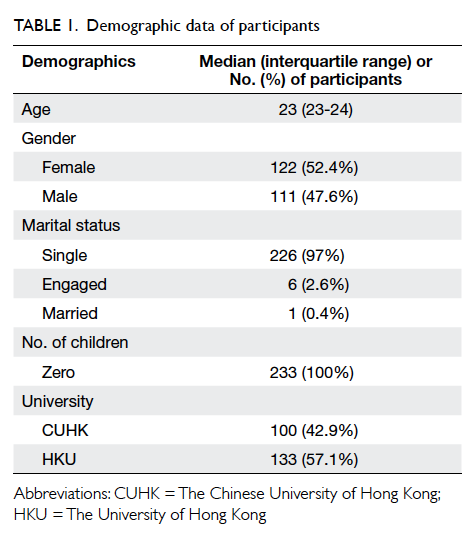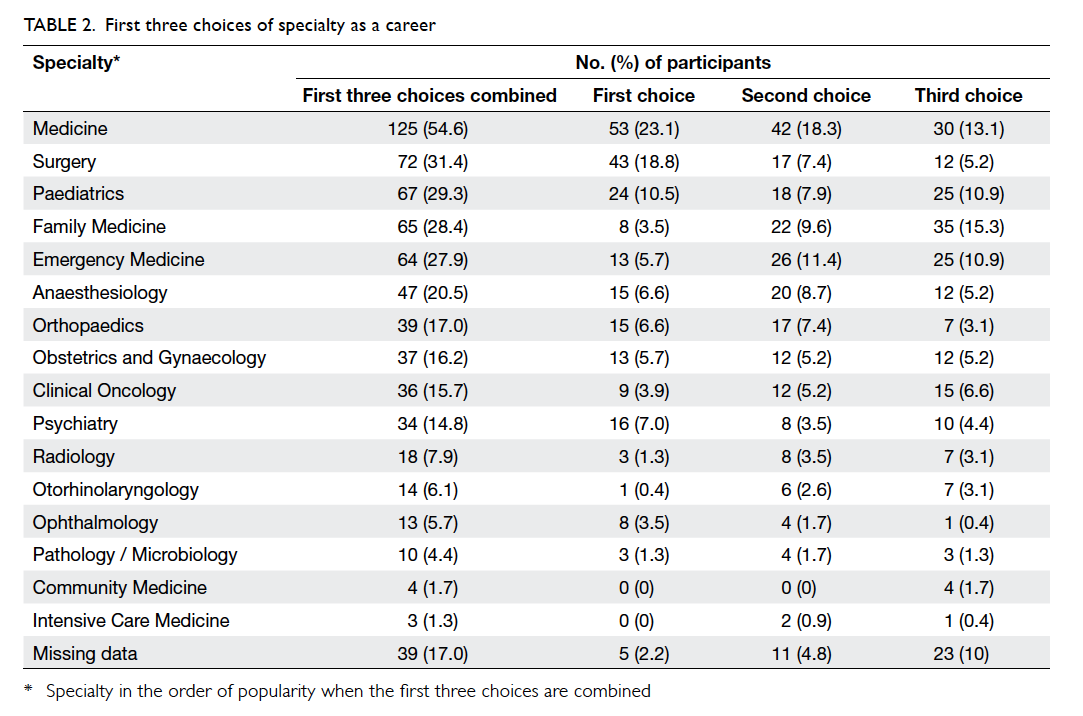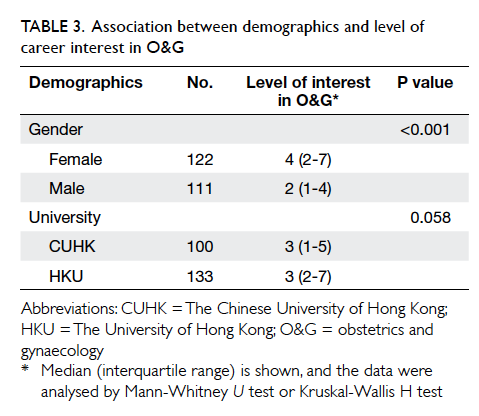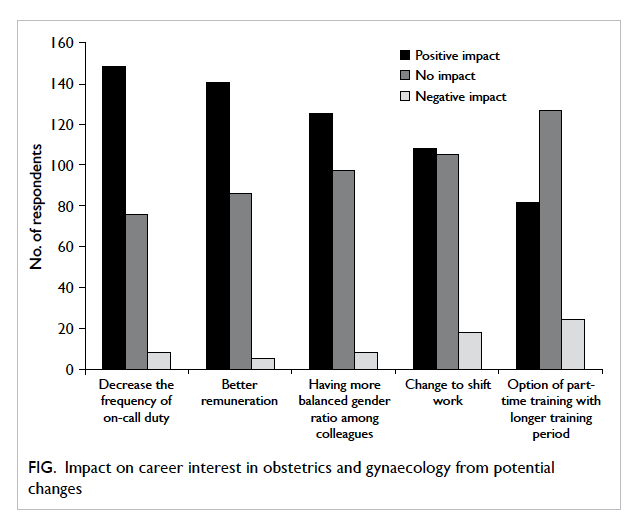Hong Kong Med J 2016 Apr;22(2):138–43 | Epub 26 Feb 2016
DOI: 10.12809/hkmj154650
© Hong Kong Academy of Medicine. CC BY-NC-ND 4.0
ORIGINAL ARTICLE
Factors influencing the career interest of medical graduates in obstetrics and gynaecology in Hong Kong: a cross-sectional questionnaire survey
Christy YY Lam, MB, BS1;
Charleen SY Cheung, MB, BS, FHKAM (Obstetrics and Gynaecology)2;
Annie SY Hui, MB, BS, FHKAM (Obstetrics and Gynaecology)3
1 Department of Obstetrics and Gynaecology, Pamela Youde Nethersole Eastern Hospital, Chai Wan, Hong Kong
2 Department of Obstetrics and Gynaecology, Queen Mary Hospital, The University of Hong Kong, Pokfulam, Hong Kong
3 Department of Obstetrics and Gynaecology, Prince of Wales Hospital, The Chinese University of Hong Kong, Shatin, Hong Kong
Corresponding author: Dr Christy YY Lam (christylamyy@gmail.com)
Abstract
Introduction: The trend of declining interest
of medical graduates in pursuing obstetrics and
gynaecology as a career has been observed in many
overseas studies. This study aimed to evaluate the
career interest of the most recent medical graduates
in Hong Kong, especially their level of interest in
obstetrics and gynaecology, and to identify key
influential factors for career choice and career
interest in obstetrics and gynaecology.
Methods: All medical graduates from the Chinese
University of Hong Kong and the University of Hong
Kong who attended the pre-internship lectures in
June 2015 were invited to participate in this cross-sectional
questionnaire survey. The main outcome
measures were the level of career interest in
obstetrics and gynaecology, the first three choices of
specialty as a career, key influential factors for career
choice, and key influential factors for career interest
in obstetrics and gynaecology.
Results: Overall, 73.7% of 323 new medical graduates
participated in the study and 233 questionnaires were analysed.
The median score (out of 10) for the level of career
interest in obstetrics and gynaecology was 3. There
were 37 (16.2%) participants in whom obstetrics and
gynaecology was among their first three choices,
of whom 29 (78.4%) were female. Obstetrics and
gynaecology ranked as the eighth most popular
career choice. By factor analysis, the strongest key
influential factor for career interest in obstetrics
and gynaecology was clerkship experience (variance
explained 28.9%) and the strongest key influential
factor for career choice was working style (variance
explained 26.4%).
Conclusions: The study confirmed a low level of
career interest in obstetrics and gynaecology among
medical graduates and a decreasing popularity
of the specialty as a career choice. The three key
influential factors for career interest in obstetrics
and gynaecology and career choice were working
style, clerkship experience, and career prospects.
New knowledge added by this study
- Career interest in obstetrics and gynaecology (O&G) was low among current medical graduates in Hong Kong.
- Medicine and surgery remained the most popular career choices among current medical graduates in Hong Kong.
- The key influential factors in career choice were working style, clerkship experience, and career prospects.
- Review of the training and working conditions of O&G doctors with regard to compatibility with a work-life balance should be undertaken to improve the competitiveness of O&G as a career choice.
- Quality of clerkship experience, including interaction with O&G doctors and nurses, should be assured to improve medical graduates’ career interest in O&G.
Introduction
In Hong Kong, career opportunities in obstetrics
and gynaecology (O&G) for medical graduates have
undergone a roller-coaster ride over the last two
decades. For O&G, the number of new trainees per
year in the territory dropped from 11 in 2000 to a
trough of five in 2004, followed by a steep rise to 22
in 2006.1 This trend was driven by multiple factors,
notably the local birth rate and the influx of non-eligible
person deliveries during this period.
According to the discussion paper ‘Manpower
requirement and strategies for doctors’ published
by the Hospital Authority in 2010, the annual intake
requirement of O&G doctors was projected to be 20
for the period 2010 to 2016.2 Recruitment of O&G
resident trainees in the latest Annual Recruitment
Exercise in 2015 was unexpectedly difficult, however.
Among the 24 O&G resident trainee posts available
in the Annual Recruitment Exercise for Resident
Trainees 2015/16,3 less than 50% were filled by May
2015 and 11 posts remained vacant in July 2015,4
thus creating a manpower crisis in O&G.
The trend of declining interest of medical
graduates in pursuing O&G as a career has likewise
been observed in overseas studies5 6 with various
factors explored, such as perception of O&G
clerkship,5 6 7 lifestyle,5 7 gender,5 7 8 and medicolegal
issues.5 7 Local data on this topic are lacking. A
literature search revealed one local study on
specialty choice of medical graduates was conducted
20 years ago9 and another focused on the specialty of
family medicine.10 In view of the recent manpower
crisis, there was an urgent need to perform a study
on this topic as it might guide manpower planning
and formulation of solutions.
The objectives of this study were to evaluate the
career interest of the most recent medical graduates
in Hong Kong, especially their level of career interest
in O&G, and to identify key influential factors for
career choice and career interest in O&G.
Methods
This was a cross-sectional questionnaire survey. All
medical graduates of the University of Hong Kong
(HKU) and the Chinese University of Hong Kong
(CUHK), who graduated in 2015 and attended the
pre-internship lectures held in their medical school
on 5 and 8 June 2015 respectively, were invited
to participate. This study was approved by the
Institutional Review Board of the University of Hong
Kong / Hospital Authority Hong Kong West Cluster
and the Joint Chinese University of Hong Kong–New Territories East Cluster Clinical Research
Ethics Committee.
All medical graduates who attended the
lectures were given an information sheet and consent
form. Those who consented were invited to complete
a self-administered anonymous questionnaire in
English that was collected on the same day by the
investigator.
The questionnaire comprised 14 questions in
three sections: (1) demographic data, (2) current view
on career choice, and (3) view on O&G as a career.
The second section explored the first three choices of
specialty as a career and the extent of influence of 28
items on career choice. The third section evaluated the current level
of career interest in O&G, the extent of influence of
28 items on career interest in O&G, and the impact
on the level of career interest in O&G of five possible
changes. The 28 items were potential influential
factors that were identified from overseas studies5 6 7 8
in the following categories: (1) ability, interest, and
personality, (2) clerkship experience, (3) influence of
family, peers, and seniors, (4) medicolegal issues, (5)
nature of the specialty, (6) other experience related
to the specialty, (7) career prospects, (8) religion,
and (9) training and working conditions.
All statistical analyses were performed using
PASW Statistics 18, Release Version 18.0.0 (SPSS
Inc., 2009, Chicago [IL], US). Categorical data were
presented as counts and percentages. Continuous
data were expressed as median (interquartile range) as
they were highly skewed. Chi squared test and Fisher’s
exact test were used to compare categorical data. For
continuous data, as they were highly skewed, a non-parametric
test (Mann-Whitney U test or Kruskal-Wallis H test) was used. Results with a P value of <0.05 were considered statistically significant.
In order to investigate the structure of the
potential factors influencing career choice and career
interest in O&G, an exploratory factor analysis
by the extraction method of principal component
analysis with varimax rotation was performed. An
exploratory factor analysis was performed instead
of a confirmatory factor analysis because the factor
structure was uncertain. The number of factors to be
extracted was based on the result from the scree-plots
and the Kaiser’s eigenvalue criterion (eigenvalue >1).
Missing values were excluded listwise. The quality of
the factor analysis models was assessed by Bartlett’s
test of sphericity and the Kaiser-Meyer-Olkin
(KMO) measure of sampling adequacy.
Results
In June 2015, there were 323 new medical graduates
in Hong Kong, of whom 163 were from HKU and 160
were from CUHK. Among them, 283 attended the
pre-internship lectures (157 HKU graduates and 126
CUHK graduates); 238 participants were recruited
who constituted 73.7% of all 323 medical graduates
and 84.1% of 283 medical graduates in the lectures.
Five questionnaires were excluded from analysis due
to significant missing data (four missing the level of
career interest in O&G and one missing the extent
of influence of factors for career interest in O&G).
Thus, 233 questionnaires were analysed.
Table 1 shows the demographic data of
participants. There were 229 (98.3%) participants
who planned to undergo specialty training after
internship. Table 2 shows the distribution of their first three choices of specialty. There were 13 (5.7%)
participants who indicated O&G as their first choice
of specialty and 37 (16.2%) participants who listed
O&G among their first three choices of specialty,
of whom 29 (78.4%) were female and eight (21.6%) were
male.
On a scale of 1 (no interest at all) to 10 (extremely
interested), the median (interquartile range) score
for the current level of career interest in O&G was
3 (1-6). The association between demographics and
level of career interest in O&G is shown in Table
3. Gender was significantly associated with level of
career interest in O&G with females more interested
than males. There was also a statistically significant
association between gender and listing O&G among
the first three choices of specialty (P=0.001).
In the exploratory factor analysis, the values
of KMO measure of sampling adequacy were >0.6.
The P values of Bartlett’s test of sphericity were
both <0.05. These figures indicated that the use of
factor analysis was appropriate to investigate the
underlying factors in this study. Eight underlying
factors were extracted for career choice and seven
underlying factors were extracted for career interest
in O&G. All had an eigenvalue of >1, implying that
these factors were meaningful. The total percentage
of variance explained by the eight underlying factors
for career choice and that for the seven underlying
factors for career interest in O&G were both 68.0%,
meaning these factors could explain 68.0% of the
condition.
The three factors with the highest percentage
of variance explained were identified as the key
influential factors. The key influential factors for
career choice and career interest in O&G are shown
in Table 4.
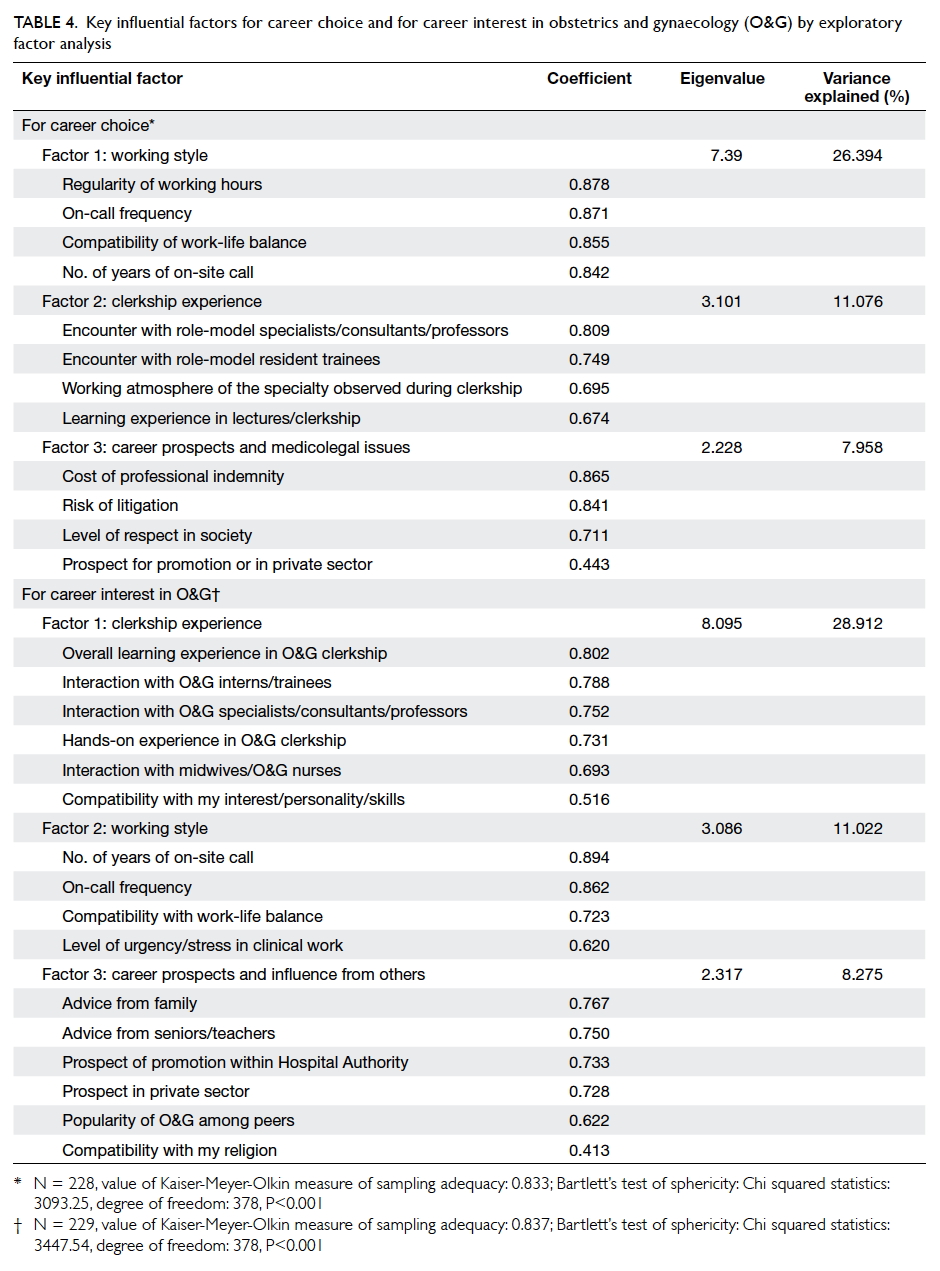
Table 4. Key influential factors for career choice and for career interest in obstetrics and gynaecology (O&G) by exploratory factor analysis
Comparison of gender with the median of
key influential factors for career choice and career
interest in O&G revealed no difference except
for clerkship experience. This was the strongest
key influential factor for career interest in O&G.
The median rating by female participants was 21
(18-24) and that for male participants was 19 (16-22)
[P=0.021].
Impact on career interest in O&G of five
potential changes was evaluated (Fig). Decreasing the
frequency of on-call duty and better remuneration
had the highest positive impact. The option of part-time
training with a longer training period had the
lowest positive impact but highest negative impact.
Discussion
To our knowledge, this is the first study in Hong
Kong to investigate the career interest of medical
graduates in O&G and the influential factors. It was
satisfactory to have a participation rate of 73.7% of
the 323 medical graduates in Hong Kong this year.
Medicine and surgery were the most popular
specialty choices. This is consistent with previous
local studies.9 10 On the other hand, O&G ranked
eighth when combined with the first three choices
and sixth as the first choice. This is a reduction from
previous local studies in which its popularity was
ranked as third9 and fourth10, respectively.
The level of career interest in O&G was
low with a median score of 3 (out of 10). Female
participants had a higher career interest in O&G
than their male counterparts, which is consistent
with overseas studies.8
The key influential factors for career choice
and career interest in O&G were consistent, namely
clerkship experience, working style, and career
prospects.
Working style was the strongest key influential
factor for career choice, with the highest percentage
of variance explained (26.4%). The items included
in this factor had a similar coefficient of around
0.8, reflecting that each item made a similar
contribution to this factor. This factor was important
to both female and male medical graduates with no
statistically significant gender difference. The focus
on a work-life balance has attracted increasing
attention, not just locally but globally, and is not
unique to the medical profession. There were 149
(63.9%) participants who considered a decreased
on-call frequency would have a positive impact on
their level of interest in O&G. This had the highest
positive impact among the five possible changes
explored. Efforts should be made to avoid the vicious
cycle of lack of manpower and increased on-call
frequency in order to maintain the attractiveness
of O&G to future generations of the profession. In
addition, providing better remuneration, such as a
special honorarium for extra on-call duties, might be
explored, especially when manpower is insufficient.
This was thought to increase career interest in O&G
by 141 (60.5%) participants.
Clerkship experience was the strongest key
influential factor for career interest in O&G with the
highest percentage of variance explained (28.9%).
Included in this factor, five items had a higher
contribution with coefficients of above 0.6, namely
(1) overall learning experience in O&G clerkship,
(2) interaction with O&G interns and trainees, (3)
interaction with O&G specialists, consultants,
and professors, (4) hands-on experience in O&G
clerkship, and (5) interaction with midwives and
O&G nurses. This result is consistent with overseas
findings of the important influence of perception
of clerkship, including interaction with O&G staff,
on career interest in O&G.5 6 It emerges that O&G nurses, midwives, interns, trainees, and specialists
play a vital role in ensuring a positive O&G clerkship
experience.
Noticeably, this was the only key influential
factor with a significant gender difference (P=0.021):
the clerkship experience of female participants had
a more positive impact on their career interest in
O&G compared with males. The reason behind
this phenomenon was beyond the scope of this
study. Interestingly, Chang et al6 suggested that
male medical students were more likely to increase
their level of career interest in O&G during the
clerkship. Assuming this finding is applicable to our
local students, further study of gender difference
in clerkship experience may help improve the
imbalanced gender ratio of O&G trainees. In our
study, 126 (54.1%) participants agreed that a more
balanced gender ratio of staff would have a positive
impact on career interest in O&G.
It might be surprising to note that some items
that might have been expected to be influential—such as interest in the specialty,10 compatibility with
personality, and availability of training posts—were
not among the key influential factors in this study.
There are several limitations of this study.
First, recruitment of participants was affected by the
attendance of medical graduates at the pre-internship
lectures: 87.6% of all medical graduates. In addition,
participation in this study was voluntary: 45 (15.9%)
of 283 medical graduates who attended the lectures
did not participate. The reason for non-participation
was not documented. There may be potential
response bias as those with a low career interest
in O&G may have been less keen to participate.
Other possible reasons for non-participation were
unwillingness to disclose career interest or uncertain
career interest. A similar study may be conducted
with interns towards the end of the internship
when career interest is usually clearer. There may be
possible changes in career interest and influential
factors at another stage of career development.
Some external factors, such as the availability
of training posts at the time of application, may
become more influential at this juncture. Second,
the findings have weak generalisability as there are
many external factors that change with time and may
be different in different parts of the world. It may be
useful to conduct similar study periodically to obtain
an updated trend to facilitate manpower planning.
Third, the items of possible influential factors
included in the questionnaire were not exhaustive
and were selected with reference to previous studies.
Conclusions
The study confirmed the observation of a low level of
career interest in O&G among medical graduates and
the decreasing popularity of O&G as a career choice.
Key influential factors for career interest in O&G
and career choice included working style, clerkship
experience, and career prospects. Encouragingly,
there are modifiable elements among these factors,
where improvement can be made by faculties,
college, frontline staff, and hospital administrators.
Acknowledgements
We would like to thank Prof TP Lam and Dr Gilberto
KK Leung, Institute of Medical and Health Sciences
Education, Li Ka Shing Faculty of Medicine, The
University of Hong Kong and Prof Tony KH Chung,
Faculty of Medicine, The Chinese University of
Hong Kong for their support and endorsement for
this study to be conducted in the Faculties. We are
grateful to Dr WC Leung, Chairman of Education
Committee, The Hone Kong College of Obstetricians
and Gynaecologists and the Chief of Service of our
respective departments: Dr Anita Yeung, Prof Ernest
HY Ng, and Dr TH Cheung, for their support. We
would also like to acknowledge Dr Carmen KM Choi
and Dr Daniel Wong for their helpful comments on
the questionnaire.
References
1. Au Yeung SK. Impact of non-eligible person deliveries in
obstetric service in Hong Kong. Hong Kong J Gynaecol
Obstet Midwifery 2006;6:41-4.
2. Manpower requirement and strategies for doctors,
Hospital Authority Administrative and Operational
Meeting Paper No 693. Available from: http://www.ha.org.
hk/haho/ho/cad_bnc/AOM-P693.pdf. Accessed 5 May
2015.
3. Posts available, Annual Recruitment Exercise for resident
trainees 2015/16, Hospital Authority. Available from:
http://www.ha.org.hk/ho/resident.htm. Accessed 5 May
2015.
4. Unfilled resident trainee post for Annual Recruitment
Exercise 2015/16, Hospital Authority. Available from:
http://www.ha.org.hk/ho/resident.htm. Accessed 3 Jul
2015.
5. Gariti DL, Zollinger TW, Look KY. Factors detracting
students from applying for an obstetrics and gynecology
residency. Am J Obstet Gynecol 2005;193:289-93. Crossref
6. Chang JC, Odrobina MR, McIntyre-Seltman K. Residents
as role models: the effect of the obstetrics and gynecology
clerkship on medical students’ career interest. J Grad Med
Educ 2010;2:341-5. Crossref
7. Fogarty CA, Bonebrake RG, Fleming AD, Haynatzki
G. Obstetrics and gynecology—to be or not to be?
Factors influencing one’s decision. Am J Obstet Gynecol
2003;189:652-4. Crossref
8. Schnuth RL, Vasilenko P, Mavis B, Marshall J. What
influences medical students to pursue careers in obstetrics
and gynecology? Am J Obstet Gynecol 2003;189:639-43. Crossref
9. Lam TP. Specialty choice of medical graduates. Hong Kong
Pract 1996;18:504-12.
10. Wu SM, Chu TK, Chan ML, Liang J, Chen JY, Wong SY. A
study on what influence medical undergraduates in Hong
Kong to choose family medicine as a career. Hong Kong
Pract 2014;36:123-31.


